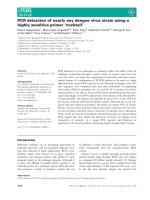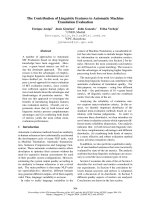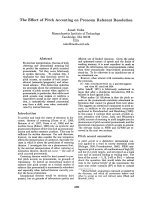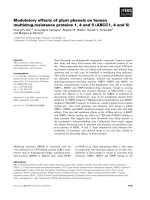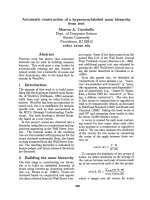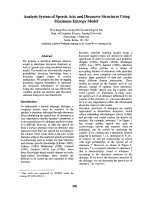Báo cáo khoa học: "Rapid measurement of trunk MOE on standing trees using RIGIDIMETER" docx
Bạn đang xem bản rút gọn của tài liệu. Xem và tải ngay bản đầy đủ của tài liệu tại đây (147.94 KB, 6 trang )
J. Launay et al.Rigidimeter
Original article
Rapid measurement of trunk MOE on standing trees
using RIGIDIMETER
Jean Launay
a*
, Milosh Ivkovich
b
, Luc Pâques
b
, Catherine Bastien
b
, Pascal Higelin
a
and
Philippe Rozenberg
b
a
ESEM Orléans, 8 rue Léonard de Vinci, 45072 Orléans Cedex 2, France
b
INRA Orléans, 45160 ARDON, France
(Received 5 July 2001; accepted 15 March 2002)
Abstract – Rigidimeter is a device developed in order to determine the modulus of elasticity (MOE) of standing trees. It was used on a hybrid
Larch clonal test located at INRA,Orléans, France. Some of the examined trees were felled and remeasured. The goal of this study was to contri
-
bute to the validation of the Rigidimeter, as a fast non-destructive and reliable tool for rapid evaluation of MOE, an important mechanical proper-
ty of wood. Two measurements in orthogonal directions improve the accuracy especially in the presence of reaction wood. We have showed that
two measurements of diameter including bark with a precision of ± 1 mm are sufficient to obtain a reliable second moment of area, which is an
important parameter for the estimation of trunk MOE. Bark MOE is small compared to wood MOE, but bark thickness influences the measure-
ment of tree diameter. A correction may be necessary to account for the presence of bark. We propose a method for estimating MOE of different
trunk layers, such as bark and mature wood layer.
genetic improvement / modulus of elasticity / standing tree evaluation / larch
Résumé – Mesure rapide du module d’élasticité des arbres sur pied à l’aide du Rigidimètre. L’appareil que nous avons développé pour me-
surer le module d’élasticité (MOE) des arbres sur pied, le Rigidimètre, est utilisé dans un test de mélèze hybride à l’INRA d’Orléans en France.
L’objectif de l’étude est de contribuer à la validation de sa fiabilité pour la détermination rapide de cette propriété mécanique importante. Nous
évaluons ici (1) la méthode de mesure du diamètre du tronc, (2) l’influence de l’écorce, (3) quelques détails de la procédure de mesure sur la pré
-
cision de l’estimation du MOE du tronc. La méthode de mesure du diamètre proposé permet d’estimer correctement le moment quadratique de la
section du tronc, un paramètre important de l’estimation du MOE. L’écorce influence l’estimation du MOE, non pas au travers de son MOE
propre qui semble très faible, mais par l’intermédiaire de son épaisseur qui fait varier le diamètre sur écorce. Nous proposons une méthodologie
de l’utilisation de l’appareil qui permet d’estimer le MOE des derniers cernes fabriqués, c’est-à-dire du bois adulte dans l’arbre sur pied.
génétique / module d’élasticité / arbre sur pied / mélèze
1. INTRODUCTION
For evaluation of genetic tests of forest trees, wood rigid
-
ity measurements are of high technological importance [21].
They can be obtained indirectly from density measurements
[1, 7, 19, 30, 32, 33] on small wood samples drilled from the
trunk. Microdensitometry gives extensive information on
radial growth, based on wood density variation along the
diameter [22]. However, the results cannot be obtained im
-
mediately. The Pilodyn tester uses the depth of needle
penetration into trunk for density estimation and gives results
rapidly at low cost [4, 5, 8, 25, 26, 29, 30]. The measurements
must be repeated to obtain statistically valid results. The
Resistograph gives also information related to wood quality
in the radial direction [3, 23]. Certain wood quality informa
-
tion can also be obtained from ultrasonic velocity measure
-
ments or stress wave techniques [9, 27].
Vafai and Farshad [28], Langbour [16], and Koizumi [10,
12] have demonstrated that it is possible to measure directly
wood rigidity on standing trees with mechanical methods,
Ann. For. Sci. 59 (2002) 465–469 465
© INRA, EDP Sciences, 2002
DOI: 10.1051/forest:2002030
* Correspondence and reprints
Tel.: 33 2 38 41 73 32; fax: 33 2 38 41 70 63; e-mail:
using bending tests. Koizumi [11, 13–15] applied success
-
fully his method in Japanese larch (Larix kaempferi) and Jap
-
anese cedar (Cryptomeria japonica) breeding programs.
Mamdy et al. [18] and Rozenberg et al. [24] used Koizumi’s
method and obtained a good correlation between the equiva
-
lent modulus of elasticity (MOE
eq
) of standing Douglas-fir
(Pseudotsuga menziesii) trunks and standardized samples cut
from the felled trees. The measurements on standing trees
must be both rapid and accurate in order to be used benefi
-
cially for tree breeding.
With these objectives, a new device, the Rigidimeter, has
been proposed [6, 17]. This device makes possible testing of
at least 50 trees per day. When used on Douglas-fir and larch
(Larix sp.) test populations, the performance of Rigidimeter
was satisfactory [17]. In this paper, further aspects concern
-
ing accuracy of measurements are discussed using results ob
-
tained from a larch experimental population. A good
accuracy is necessary in order to use Rigidimeter as discrimi
-
nating device for rigidity of mature wood. First, we explain a
proper way to perform MOE measurements using a bending
test. Secondly, we examine the effects of (i) trunk taper and
crookedness, (ii) cross-sectional shape, (iii) presence of bark
and (iv) juvenile wood on the precision of MOE evaluations.
2. MATERIALS AND METHODS
2.1. Description of Larix test population
The experimental population used here is a part of the retrospec-
tive clonal trial (INRA-Orléans nursery). The test includes 62 clones
of hybrid larch (EL × JL) from 4 full-sib families. Material was pre
-
pared from cuttings set in the spring of 1992. The nursery trial was
planted in 1994 at a 1 × 1 m spacing. The design was a complete ran
-
domized block design with 8 blocks and one-tree plots. A systematic
and a genetic thinning were carried out at the beginning of 1998.
From the final cut in 2001, 108 trees representing 20 clones were
used for our experiment.
2.2. MOE measurement using a bending test
In this paper, a tree trunk is considered as a beam. Based on this
hypothesis, the best way to perform a bending test on a standing tree
is to obtain a constant bending moment (M) along the trunk. In
figure 1 two possibilities are presented: the principle of Koizumi’s
device (figure 1a) and the principle of Rigidimeter (figure 1b).
The radius of curvature (R) is constant when M is constant. The
measurement of displacement (v), with the crossbar attached to the
trunk, gives R (figure 2).
For a cylindrical trunk, its diameter (d) gives the second moment
of area (I): I = π d
4
/ 64. The trunk equivalent modulus of elasticity
MOE
eq
is then calculated from the relationship MOE
eq
=MR/I.For
an elliptical trunk, characteristics of a section differ depending on
the direction of measurement. Two main second moment of area
corresponding to the long (I1) and short (I2) axes of the ellipse
should be used. Rigidimeter should be applied in the planes contain
-
ing the two directions of reference for each tree. M must be large
enough to obtain a displacement of about 1 mm assuming a preci-
sion of about 1% for R, and not too high to damage the trunk wood
by an excessive compression stress in the transversal direction, (i.e.
it must not exceed 10 to 20 MPa). With the latest model of the
Rigidimeter, the load is applied with a precision greater than 1%, by
two 10 kN hydraulic jacks. To avoid damage to the bark under the
Rigidimeter’s supports, the area of the supports must be large
enough to reduce the pressure. The best time for using Rigidimeter
is also before or after the growing period.
2.3. Causes of measurement imprecision
2.3.1. Taper and crookedness
Measurement imprecision comes primarily from variation of the
second moment of area I, on which are based the above relation
-
ships. Consistency of I along the trunk axis is assumed, but in real
-
ity, it is rarely obtained. Many trunks are not cylindrical but conical
in shape and crooked. Stem taper and crookedness influences on
MOE are simulated with a Finite Element Method (FEM) using
beam elements. This method, currently used in mechanical engi
-
neering, rapidly gives a numerical solution (i.e., the displacement)
to this problem [31].
2.3.2. Cross-sectional shape
Cross sections are usually assumed to be circular, which is infre
-
quently the case. These irregularities in shape also indicate the pres
-
ence of reaction wood with heterogeneous density and rigidity. For
this reason, two sets of measurements were made on each tree in two
orthogonal directions (i.e., two compass directions). Diameter mea
-
surements were verified using scanned images of cross-sections of
62 felled trunks. The cross-sections were cut at the same position
where measurements were made on standing trees. The real value of
the second moment of area, in each direction, was calculated di
-
rectly using the image processing tool incorporated in Matlab 5.3
466 J. Launay et al.
Figure 1. Principle of two bending tests on standing tree (for more de
-
tails see [12] and [17]).
Figure 2. Principle of the trunk radius of curvature measurement.
(1999). Real diameters in two directions were deduced and statisti
-
cally compared with the observed values, using the least square
method.
2.3.3. Presence of bark
In order to simplify the measurement process, diameter is ob
-
tained in those two directions including the bark. Thus MOE
eq
in
-
cludes bark stiffness which is smaller than wood rigidity [20]. One
can consider that each annual ring (i) is concentric and has a specific
longitudinal MOE termed E
i.
The trunk equivalent bending stiffness
is then equal to the sum of the bending rigidity of each layer [2, 7]
(Eq. (1)).
MOE I E I
eq trunk i i
i= 1
N
=
∑
(1)
If bark is considered the outermost layer (N) of the elastic modu
-
lus E
b
,d
ext
is the trunk diameter over bark, and d
int
is the trunk diame
-
ter under bark, then equation (1) can be modified to give equation
(2):
MOE d E d d E d d
eq ext
4
bext
4
int
4
ii+1
4
i
4
i= 1
N–1
=+
∑
(–) (–)
(2)
Two methods were used to measure E
b
:
(a) Tensile tests with a INSTRON
TM
machine equiped with 5000 N
load cell and mechanical extensometer. Five bark samples
(200 × 20 mm) were collected from 3 trees immediately after fell-
ing.
(b) Bending tests on five felled trunks 2 meters long, with and with-
out bark.
Predicted and observed values seemed to be in good agreement,
but could not be statistically compared due to the small sample size.
2.3.4. Presence of juvenile wood
For a young tree, heterogeneity of density and rigidity comes
from the presence of highly variable juvenile wood core, which can
occupy a large part of its cross section. Bending stiffness therefore
depends on both juvenile and mature wood MOE, and to some ex
-
tent on bark MOE. As shown for bark, two subsequent measure
-
ments using the Rigidimeter make it possible to extract the MOE of
an external layer. This technique can be applied to find the MOE of
the one or several outermost annual rings comprising only mature
wood. The Rigidimeter’s ability to detect a certain difference in
MOE between juvenile and mature wood was examined by sensitiv
-
ity analyses using computer simulations.
3. RESULTS AND DISCUSSION
3.1. Effect of stem taper and crookedness on MOE
eq
values
The Finite Element Method with beam elements, was used
to simulate the radius of curvature for a crooked tree. For a
crooked trunk with a deviation of up to 50 mm, the radius of
curvature was not different from that of a strait trunk. For a
trunk, of conical shape (e.g. with a diameter decrease of
10 mm m
–1
) the radius of curvature was only slightly (e.g.
1%) less than for a trunk of cylindrical shape. As a conse
-
quence MOE was also decreased by the same amount. These
results suggest that natural geometry variations do not affect
significantly the MOE measurement.
3.2. Trunk diameter measurement: influence
of a non-circular cross-section
Trunk cross-section can be considered circular if growth is
regular. Diameter is usually, measured with a precision of
1 mm; thus for a diameter of 150 mm, uncertainty regarding
the second moment of area (I) is approximately 3%. Under
the influence of a prevailing wind, the tree reacts and modi
-
fies its wood by creating reaction wood and an elliptical
cross-section [32]. Measurement of the radius of curvature
and thus estimation of MOE depends on this direction for
geometric reasons and because of mechanical variations in
trunk cross-section.
For practical reasons, MOE is usually measured by
Rigidimeter positioned in two orthogonal directions, with the
same reference direction for all trees. Two diameter values
used in MOE calculations are obtained for each tree by taking
measurements in the same directions. We obtained a maxi
-
mum difference between two diameters measured on stand
-
ing larch trees of ± 6 mm. Those diameter values were
compared with diameters deduced from the real value of the
second moment of area obtained from the scanned images of
cross-sections (figure 3). The slope of the regression line was
0.99 with an R
2
of 0.91. Calculating two MOE values for each
tree from diameter measurements made on standing trees is
thus a good approach, because the obtained second moment
of area is close to the real value. Two different values of MOE
obtained in two different directions show that wood material
varies with the orientation within a cross-section, and per-
haps indicates the presence of reaction wood. Consequently,
the magnitude of these two values can be used to study the ef
-
fect of the prevailing wind or the terrain slope on the forma
-
tion of reaction wood.
3.3. Influence of bark
Although, it is faster to measure diameter over bark, the
resulting MOE includes the bark rigidity that can modify the
Rigidimeter 467
Figure 3. Comparison of the trunk diameter measurements.
classification of trees in a population. To evaluate this influ
-
ence, we used the relationships from equation (2) adapted to
this particular problem. Assuming trunk wood is homoge
-
neous and has a modulus of elasticity E
w
, then bark MOE E
b
can be obtained from equation (3):
E
MOE d – E d
d–d
b
eq ext
4
w
int
4
ext
4
int
4
=
(3)
Similarly, wood MOE E
w
can be estimate from MOE
eq
with
the bark correction of equation (4).
E
MOE d –E (d –d
d
w
eq ext
4
b
ext
4
int
4
int
4
=
)
(4)
From the two methods used to measure E
b
(a tensile test on a
bark sample and a bending test on five felled trunks with and
without bark) we obtained mean values ± standard deviations
of 60 ± 25 and 45 ± 20 MPa, respectively. It must be remarked
that the low bark MOE gives a minor contribution to the trunk
bending rigidity. A mean bark thickness of 5 mm (± 0.5 mm)
was measured on the felled tree cross sections. If bark thick
-
ness in a tree population is uniform figure 4 shows that for
different trunk diameters, the ranking within a population
may be changed, by measuring diameters including bark. In
that case, a correction accounting for the presence of bark is
necessary.
3.4. Presence of juvenile wood
The modulus of elasticity measured on young trees may be
different from that measured on the same trees when older. It
may be desirable to classify trees using the outer mature
wood portion. As it was shown previously, with two subse-
quent measurements using Rigidimeter it is possible to ex
-
tract the MOE of an external layer. This technique could be
applied to find, for example, the MOE of two last annual
rings. The procedure was simulated under the following as
-
sumptions. By applying a load of 10000 N to a trunk with
150 mm in diameter (dbh) and with MOE of 8000 MPa for
the juvenile wood, the measured displacement v would be
1.89 mm. Such a tree may have a cambial age of 15 years at
dbh, if radial growth is on average 10 mm per year. The
Rigidimeter can then be used after two years to re-measure
the MOE including the two last annual rings. If they corre
-
spond to mature wood, an increase of 20% in MOE can be ex
-
pected for those two last rings. With the same growth in
diameter (10 mm year
–1
) the displacement would be 1.06 mm.
If the two last annual rings are of juvenile wood, with the
same diameter (170 mm) the displacement would be
1.14 mm. The two consecutive Rigidimeter measurements
would detect the difference (0.08 mm) and indicate a differ
-
ence in MOE due to mature wood. It should be noted that the
MOE of external annual rings can be measured with better ac
-
curacy than the MOE of bark, because wood has a greater
bending rigidity than bark.
4. CONCLUSION
The purpose of the Rigidimeter is for the evaluation in tree
breeding. It is an accurate bending device able to test trunks
of about 80 to 200 mm in diameter. To optimise its use, dis-
placement measured to obtain the radius of curvature must be
approximately 1 mm. Two sets of measurements in orthogo-
nal directions improve the accuracy, especially if reaction
wood is present. We have showed that diameter measurement
at±1mmincluding bark is sufficient to obtain the second
moment of area.
Trunk MOE differs from wood MOE, but that should not
modify the ranking of trees within a population if the varia-
tion of bark thickness and diameter are small. If the bark
thickness and diameter within the population are heteroge-
neous, it is necessary to include a correction factor for the cal
-
culation of wood MOE.
We also propose the use of this device at two subsequent
times in order to obtain MOE of mature wood layer. The first
measurement gives the estimate for the juvenile core. MOE
of the newly accumulated mature wood layer can be deter
-
mined from the second measurement. The results of simula
-
tion presented in the section 3.4 suggest that the difference of
displacement between a more juvenile and more adult tree is
measurable. The MOE of the mature wood layer can be used
as a classification criterion in tree selection and breeding.
REFERENCES
[1] Armstrong J.P., Skaar C., de Zeeuw C., The effect of specific gravity
on several mechanical properties of some world woods, Wood Sci. Tech. 18
(1984), 137–146.
[2] Bodig J., Jayne B.A., Mechanics of wood and wood composites, Van
Nostrand Reinhold Company, New York, Cincinnati, Toronto, London, Mel
-
bourne, 1982.
[3] Chantre G., Rozenberg P., Can drill resistance profiles (Resisto
-
graph), lead to within-profile and within-ring density parameters in Dou
-
glas-fir wood, in: Proceedings of Timber Management Toward Wood
468 J. Launay et al.
Figure 4. Comparison of the trunk MOE with and without bark.
Quality and End-Product Value, CTIA/IUFRO International Wood Quality
Workshop, August 18–22, 1997, Québec City, pp. II 41–46.
[4] Chantre G., Sutter-Barrot E., Gouma R., Bouvet A., De l’intérêt de
l’utilisation du Pilodyn dans l’étude de la qualité du bois : application à l’épi
-
céa commun et à l’épicéa de Sitka, Annales AFOCEL 1992, 145–177.
[5] Cown D.J., Use of the Pilodyn wood tester for estimating wood density
in standing trees – influence of site and tree age. Forest Research Institute,
New Zealand Forest Service, bulletin No 13, 1981.
[6] Dewitte J.M., Outils et méthode pour l’amélioration génétique des ar
-
bres forestiers en milieu naturel : le rigidimètre, Mémoire Ingénieur CNAM
Orléans, 1998.
[7] Guitard D., Mécanique du bois et composites, Cepadues éditions,
France, 1987.
[8] Hoffmeyer P., The Pilodyn instrument as a non-destructive tester of the
shock resistance of wood, in: Proceedings of the 4th symposium on non des
-
tructive testing of wood, Pullman, Washington, USA, 1978, pp. 47–66.
[9] Ikeda K., Kanamori F., Arima T., Quality evaluation of standing trees
by stress wave propagation method and its application. IV. Application to qua
-
lity evaluation of hinoki (Chamaecyparis obutusa) forests, Mokuzai Gakkais
-
hi/Journal of the Japan Wood Research Society, 46 (6) (2000) 602–608.
[10] Koizumi A., Studies on the estimation of the mechanical properties of
standing trees by non-destructive bending test, Bulletin of the College Experi
-
ment Forest, Faculty of Agriculture, Hokkaido University, 44 (4) (1987)
1329–1415.
[11] Koizumi A., Variability in wood quality of Japanese larch observed
by tree bending tests,19th IUFRO congress, Montreal, 1990, 7 p.
[12] Koizumi A., Ueda K., Estimation of the mechanical properties of
standing trees by non-destructive bending tests, Mokuzai Gakkashi 39 (2)
(1986) 669–676.
[13] Koizumi A., Takada K., Ueda K., Radial growth and wood quality of
plus trees of Japanese larch II. Diameters at breast heights and trunk moduli of
elasticity of 18-year-old offspring families, Mokuzai Gakkaishi, 36 (9) (1990)
704–708.
[14] Koizumi A., Takada K., Ueda K., Variation in modulus of elasticity
among Japanese larch from different provenances, in: Proceedings of the
IUFRO working party S2.02–07, Berlin, 5–12 September, 1992, pp. 66–72.
[15] Koizumi A., Takada K., Ueda K., Katayose T., Radial growth and
wood quality of plus trees of Japanese larch I. Radial growth, density, trunk
modulus of elasticity of grafted clones, Mokuzai Gakkaishi, 36 (2) (1990)
98–102.
[16] Langbour P., Rigidité de l’arbre sur pied, indicateur de l’élasticité lon
-
gitudinale du bois, application aux peupliers. Thèse INPL Nancy, 1989, 136p.
[17] Launay J., Rozenberg P., Pâques L., Dewitte J.M., A new experimen
-
tal device for rapid measurement of the trunk equivalent modulus of elasticity
on standing trees, Ann. For. Sci. 57 (2000) 351–359.
[18] Mamdy C., Rozenberg P., Franc A., Launay J., Scherman N., Bastien
J.C., Genetic control of stiffness of standing Douglas fir; from the standing
stem to the standardised wood sample, relationships between modulus of elas
-
ticity and wood density parameters. Part 1, Ann. For. Sci. 56 (1999) 133–143.
[19] Nepveu G., La variabilité du bois, in: Le matériau bois, 2
e
éd.,
ARBOLOR, Nancy, 1991.
[20] Niklas K.J., The mechanical role of bark, Am. J. Bot., 86 (4) (1999)
465–469.
[21] Panshin A.J., de Zeeuw C., Textbook of wood technology, McGraw
Hill Book Co., New York, 1980, 722 p.
[22] Polge H., Établissement des courbes de variation de la densité du bois
par exploration densitométrique de radiographies d’échantillons prélevés à la
tarière sur des arbres vivants. Application dans les domaines technologiques et
physiologiques. Thèse de Doctorat, Université de Nancy, France, 1966.
[23] Rinn F., Schweingruber F.H., Schär E., RESISTOGRAPH and X-ray
density charts of wood: comparative evaluation of drill resistance profiles and
X-ray density charts of different species, Holzforschung 50 (1996) 303–311.
[24] Rozenberg P., Franc A., Mamdy C., Launay J., Scherman N., Bastien
J.C., Genetic control of stiffness of standing Douglas fir; from the standing
stem to the standardised wood sample, relationships between modulus of elas
-
ticity and wood density parameters. Part 2, Ann. For. Sci., 56 (1999) 145–154.
[25] Rozenberg P., Van de Sype H., Genetic variation of the Pilodyn-girth
relationship in Norway pine spruce (Picea abies L (Karst)) Ann. Sc. For. 53
(1996) 1153–1166.
[26] Sprague J.R., Talbert J.T., Jett J.B., Bryant R.L., Utility of the Pilodyn
in selection for mature wood specific gravity in Loblolly pine, For. Sci. 29 (4)
(1983) 696–701.
[27] Tanaka T., Divos F., Facan T., Evaluation of residual bending
strength of wood with artificial defect(s) by stress wave, in: Proc. of the
Annual Meeting of the Japanese Wood Research Society, 1997.
[28] Vafai A., Farshad M., Modulus of elasticity of wood in standing tree,
Wood Sci., 12 (2) (1979) 93–97.
[29] Villeneuve M., Morgenstern E.K., Sebastian L.P., Estimation of
wood density in family tests of jack pine and black spruce using the Pilodyn
tester, Can. J. For. Res. 17 (1987) 1147–1149.
[30] Zhang S.Y., Effect of growth rate on wood specific gravity and selec-
ted mechanical properties in individual species from distinct wood categories,
Wood Sci. Tech. 29 (1995) 451–465.
[31] Zienkiewicz O.C., The finite element method, Mac GrawHill, 1989.
[32] Zobel B.J., van Buijtenen J.P., Wood variation, its causes and control,
Springer-Verlag, Berlin, 1989, 363 p.
[33] Zobel B.J., Jett B.J., Genetics of Wood Production, Springer-Verlag,
Berlin, 1995, 337 p.
Rigidimeter 469
